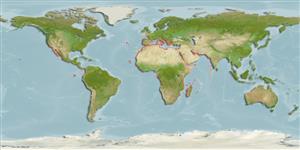Common names from other countries
Environment: milieu / climate zone / depth range / distribution range
Sinh thái học
; Thuộc về nước lợ; Mức độ sâu 0 - 2 m (Ref. 80843). Tropical, preferred 23°C (Ref. 107945); 52°N - 35°S, 123°W - 75°E
Circumglobal.
Length at first maturity / Bộ gần gũi / Khối lượng (Trọng lượng) / Age
Maturity: Lm ? range ? - ? cm Max length : 1.5 cm TL con đực/không giới tính; (Ref. 101378)
Inhabits extreme environments such as salt lakes or brine waters, coastal or inland (Ref. 105262), just like saline lakes, and coastal salterns (Ref. 105501). Its nauplii is an irreplaceable live feed for marine and shrimp larvae. Latent eggs cysts are known to withstand long drought periods at severe hypersalinity (Ref. 105261). In an experiment, adults are fed with the dinoflagellate Gyrodinium corsicum and Cryptophyta Rhodomonas baltica (Ref. 105262).
Life cycle and mating behavior
Chín muồi sinh dục | Sự tái sinh sản | Đẻ trứng | Các trứng | Sự sinh sản | Ấu trùng
Reproduction mode may be oviparous or oviviparous, depending on environmental conditions. Copulation is present. Life cycle: Eggs may either develop into nauplia (larvae) or may stay as cysts (dormant) to survive the drought period before hatching into nauplia.
Bisby, F.A., M.A. Ruggiero, K.L. Wilson, M. Cachuela-Palacio, S.W. Kimani, Y.R. Roskov, A. Soulier-Perkins and J. van Hertum. 2005. (Ref. 19)
IUCN Red List Status (Ref. 130435)
CITES status (Ref. 108899)
Not Evaluated
Not Evaluated
Human uses
Các nghề cá: Tính thương mại; Nuôi trồng thủy sản: Tính thương mại
FAO - Nuôi trồng thủy sản: Sản xuất; Các nghề cá: landings | FishSource | Biển chung quanh ta
Các công cụ
Thêm thông tin
Age/SizeSự sinh trưởngLength-weightLength-lengthHình thái họcẤu trùngSự phong phú
Các nguồn internet
Estimates based on models
Price category
Unknown.
